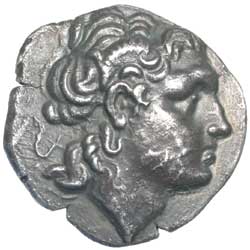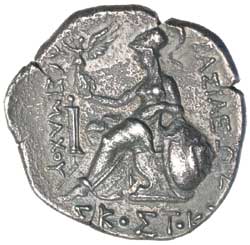Greek Silver & Bronze


Lot 3415 Session 11 (9.30am Thursday) Greek Silver & Bronze
Estimate $1,300
Bid at live.noble.com.au
SOLD $1,200
THRACE, Kingdom of, Skostokos. (c.277-260 BC), silver tetradrachm, (15.902 grams), struck at Ainos, obv. diademed head of deified Alexander right, with horn of Ammon, rev. **BASILEWS LUSIMACOU*, Athena Nikephoros seated left, holding Nike in extended right hand, left arm resting on shield, spear behind; herm to inner left, **SKOSTOK[OU]* in exergue, (SNG Cop. 1171; SNG Ash. 3779; Youroukova 'Coins of the Ancient Thracians' BARS 4, No.103 (Pl.x)). Toned, very fine or better, ragged edge with light porosity, in high relief and very rare.
Ex Classical Numismatic Group Sale 67, September 22, 2004 (lot 509); Sotheby's, Zurich Auction Sale, October 27, 1993 (lot 369) and previously in Numismatic Fine Arts Sale XXV, November 29, 1990 (lot 59, illustrated). Skostokos was a Thracian or Scythian dynast who took control of the city of Ainos (where, according to Morkholm, these coins were struck) during the unsettled period following Lysimachos' death. Youroukova hypothesizes that he perished in the course of the Celtic invasion of 279-278 B.C., suggesting an issue date of about 280 B.C. Other writers and cataloguers suggest a later date of issue as noted above. Skostokos is known to us solely from his coins, which were struck at the Thacian port of Ainos (Enez, southwest Turkey) and at Cabyle (Yambol, Eastern Bulgaria) in the Celtic kingdom of Tylis. Like Cavaros `the champion' who was the last Celtic king of Tylis, Skostokos or his father may have been one of the thousands of Celtic warriors who migrated eastwards into Thrace and Galatia after their looting raid on Delphi in 279 BC. It is probable that his name may provide a clue to his nationality. It appears to be derived from two Celtic words, succos `pig' and toccos `buttock' (Xavier Delamarre, Dictionnairede la langue gauloise, 2nd edition, 2203, pp.285, 304). Piggy personal names - Succus, Sucio, Socco, Succius, Succamo, Successus- were common in Gaul and are indicative of the Celts' intense interest in pigs and their love of pork, as attested by Strabo (IV,4.3). Dr Robert Forrer is firmly of the opinion that Scostocos was of Celtic origin and says: 'I myself want to put Skostokos rather more closely in time to the Gallo-Thracian king Cavarus, to compare the two and consider him as a successor to the Gallic kings who came into power in Thrace after the invasion of the Gauls in 280 BC, a successor of those Gauls who invaded Lysimachia in 279, occupied the whole of the Chersonese, created all sorts of small independent Celtic kingdoms in Thrace and disrupted the whole of the south from here for 70 years. I prefer to read the name itself as Skostokos and to link it linguistically with the Gallic name Coiosticos-Casticus' (Keltishe Numismatik der Rhein - und Donaulande, ed. Karel Castlin, 1968, Vol.I, p.203).
Estimate / sale price does not include buyer's premium (currently 22% including GST) which is added to hammer price. All bids are executed on the understanding that the Terms & Conditions of sale have been read and accepted. For information on grading and estimates please refer to the Buying at Auction advice.
Quick find
View a lot by number and sale.
Adjacent lots
Lot 3413
THRACE, Kingdom of, Lysimachos, (323-281 B.C.), silver tetradrachm, (16.586 grams), Lampsacus mint, issued before 282/1 ...
Estimate $600
Lot 3414
THRACE, Kingdom of Lysimachos, (323-281 B.C.), silver drachm, (4.198 grams), Colophon mint, struck 301-297 B.C., ...
Estimate $150
Lot 3415 This lot
THRACE, Kingdom of, Skostokos. (c.277-260 BC), silver tetradrachm, (15.902 grams), struck at Ainos, obv. diademed ...
Estimate $1,300
Lot 3416
THRACE, Kingdom of, Rhoemetalkes I, (11 B.C.- A.D. 12), AE 18, (3.478 grams), obv. fasces ...
Estimate $80
Lot 3417
THRACE, Kingdom of, Rhoemetalces I, (11 B.c. - A.D. 12), AE 22, (10.594 grams), obv. ...
Estimate $200